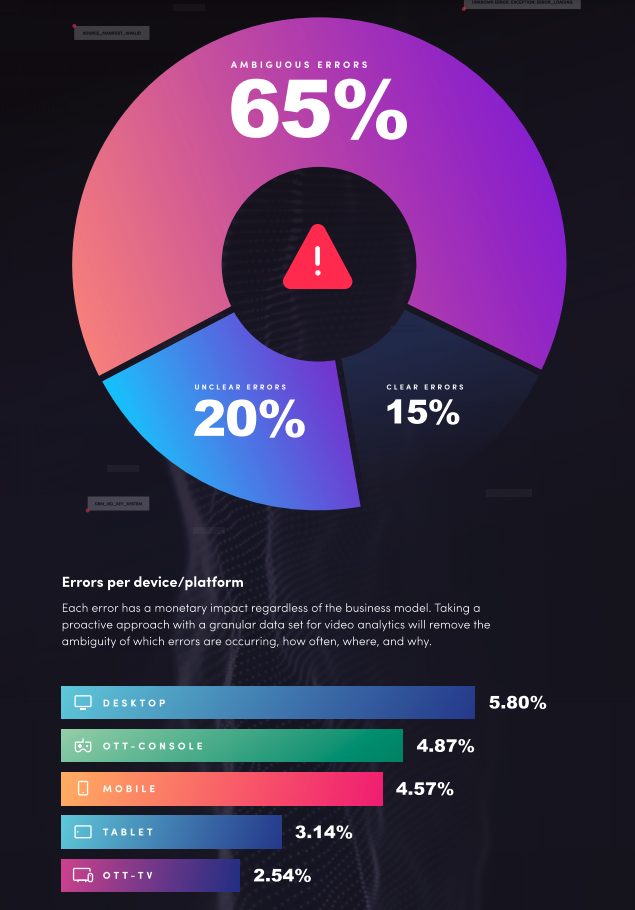Errors cost more than OTT providers realize—here’s how to tackle them
SVOD and AVOD providers cannot afford to overlook the hiccups hampering the viewer experience

The average revenue per user (ARPU) is everything to streaming video providers, whether subscription-based or ad-based. But few may realize that a service’s reliability, stability, and performance can be the difference between revenue growth and decline.
A recent report found that 6% of subscribers have canceled a streaming video service due to technical issues, such as startup times—or in-stream failures. This percentage may vary per demographic, with older generations having a lower tolerance for error due to their experience with low-error applications, such as traditional TV. But if consumers are willing to leave because of, say, repeated buffering, this would be a massive problem for streaming stalwarts and newcomers alike.
This may be unfortunate news for the plethora of OTT services that debuted in the last few years, ready to impress consumers with an abundance of new content. If launched without a plan to address errors, these streaming video providers can potentially damage their brands on a global scale.
With little time or resources to properly debug and fix errors before release, it is critical that OTT services can determine the cost of their errors as well as their root cause. But they must also identify unknown errors and tackle them head-on to deliver the best video experience possible.
Errors may be costlier than you think
Based on the aforementioned report the ARPU across all SVOD service types is $15. This means that a 6% churn rate would create an average lifetime value of $250, or 500 days of subscriber loyalty (LTV Formula: ARPU/Churn Rate/Subscription Price*30 days). Our own internal data show that the average OTT provider experiences a 6.6% error rate. If individual subscribers attempt an average of 150 plays per month, this would amount to 0.33 errors every day or 165 errors over a 500-day period.
Now consider the three primary types of errors and the frequency with which they appear. An analysis of our internal database indicated that clear errors – those that point to specific and identifiable error behaviors—account for just 15% of all errors. The rest are either ambiguous (65%) or entirely unclear (20%). In other words, the least informative errors are causing the most problems for OTT providers.
If a streaming service could eliminate 10% of their “unclear” or “ambiguous” errors with more accurate information, the LVT would increase by 1.1%, adding 5 days to the subscriber tally. That may not sound like much, but when multiplied by the many users of each service, a mere 10% reduction in errors could result in a revenue increase of $160,000 for every 1 million subscribers. Ad-based streaming video providers, which must hold onto as many eyeballs as possible in order to maximize profits, could increase their revenue by reducing their errors as well.
The professional video industry's #1 source for news, trends and product and tech information. Sign up below.
Given the potential revenue at stake, SVOD or AVOD services need to take action and understand how to tackle their most challenging errors. They can begin by looking at patterns involving how or when errors occurred.
Use granular analytics to unearth and overcome errors
Errors come in all shapes and sizes, so it’s important to zero in on any trends that may indicate the cause. When looking at the timeline, for example, consider any events that may have occurred when the errors appeared. It is wholly possible that a sudden spike in traffic, either during a holiday or when new content debuted, is responsible. Regional outages, which affect some but not all users, may also be to blame.
However, often errors do begin in other parts of the video workflow such as DRM and content protection. This is an aspect that is often overlooked or not considered in the early investigations of errors.
Error percentages and the frequency of error codes should also be examined to determine if there are any notable patterns. Any that appear—perhaps relating to a particular video or domain, or even a web browser or operating system—could provide the context needed to pinpoint and quickly resolve the issue. If that’s not enough, OTT providers can take a few steps to get to the bottom of their problems by using some of the most granular analytics to fill in the gaps of missing information:
1. Take a closer look at the error details
It is useful to review the error details from individual sessions, which can provide more insight into the problems at hand. From available user bandwidth to video quality consistency and/or the frequency and severity of buffering, this information can help streaming video services determine whether or not the issues are continuous. It will also help reveal if the issue is sourced from the service or came from external factors that are out of its control.
2. Explore the stack traces of web or app use
What happens if multiple issues potentially fit the same error code or message? In that instance, OTT providers can do a deep dive into the stack traces of web or app use. This will help remove the anonymity of the error by mapping it to an actual cause.
3. Review network information
If neither of these approaches has provided enough information to persevere, there is one more option: review where the error occurred by looking at the last network requests for every viewer session. Issues can be difficult to replicate in isolation. But if each individual error is clearly displayed as it occurred in real-time, it allows for critical analysis and successful debugging of the specific issue.
Don’t lose eyeballs to an unsightly problem
Churn is inevitable—it is simply impossible to guarantee that every user will stay with every streaming video service until the end of time. Churn can also be cyclical—users will only subscribe to 5-6 services at a time to consume the content they want.
But errors should not be the reason that they leave and stay away forever. With 6% of users abandoning streaming services after enduring one too many technical errors, the issue is clear: SVOD and AVOD providers cannot afford to overlook the hiccups hampering the viewer experience. They must work hard to locate, identify and rectify their errors to ensure that they aren’t losing eyeballs to an unsightly problem.
Stefan Lederer is Co-Founder and CEO of Bitmovin

